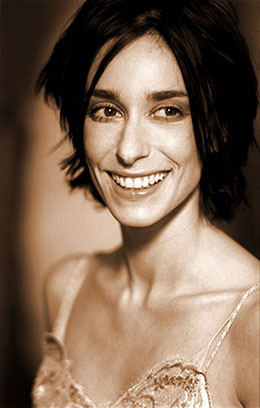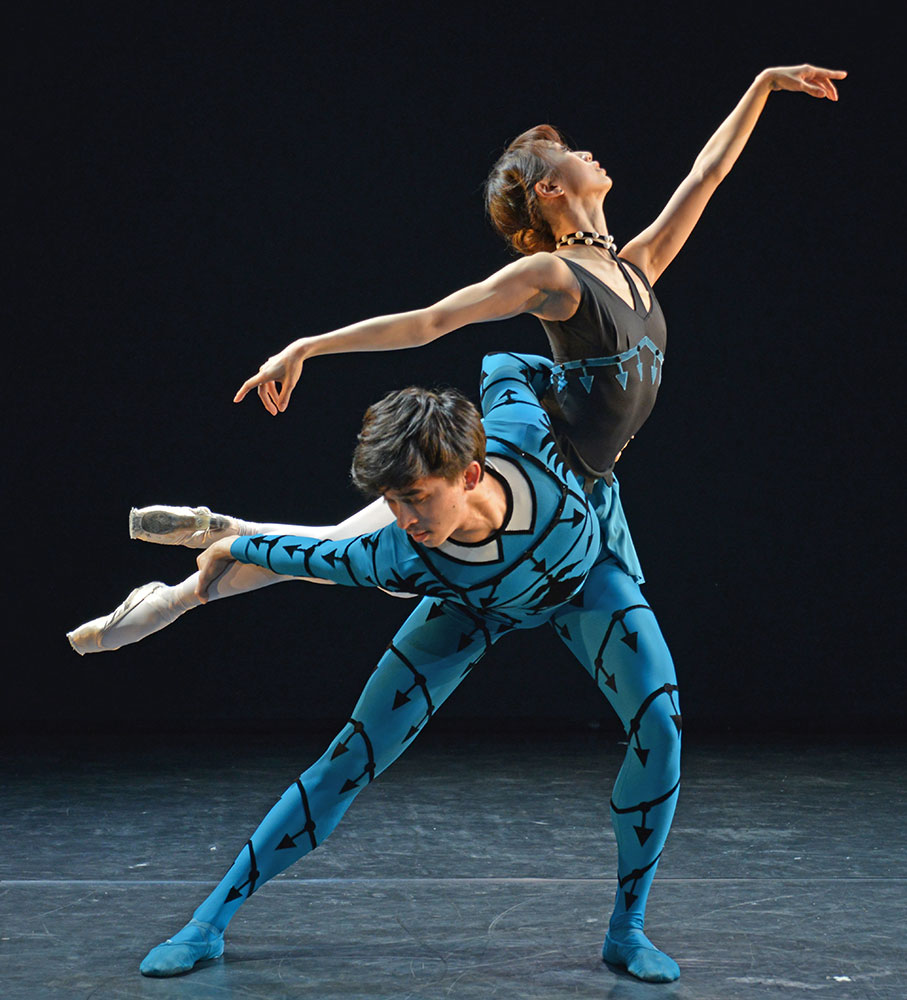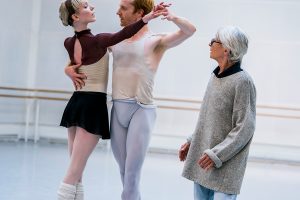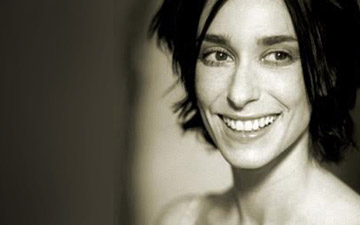
© Zoë Dominic. (Click image for larger version)
Kenneth MacMillan: Steps Back in Time, at the Barbican Pit, presented by Viviana Durante Company and featuring dancers from the Royal Ballet, Scottish Ballet and Ballet Black.
www.viviana-durante.com
www.kennethmacmillan.com
www.barbican.org.uk

© David Scheinmann. (Click image for larger version)
Viviana Durante, one of the foremost dramatic ballerinas of her generation became a principal of the Royal Ballet at just 21. Acknowledged as one of the great MacMillan interpreters, she has danced in all his major ballets around the world and increasingly teaches and coaches his (and others’) works. To celebrate MacMillan’s legacy and to mark 25 years since his death, Durante is showcasing three very rarely seen early works: House of Birds, Danses Concertantes and Laiderette, the latter staged in full. We wanted to know more about the shows (long since sold out – pray for returns), how it all came to be and her broader plans for the future.
Our conversation jumped around so I’m presenting it in a rather different format – as a series of quotes under various headings: enjoy…
What was the drive for Kenneth MacMillan: Steps Back in Time?
I was reading about his early works because it was fascinating how he became Kenneth MacMillan.
You can see what/who Kenneth MacMillan was at an early stage and the intensity of his psychology and his personal delicacy on what characters might be going through – celebrating but at the same time showing something that could belong to all of us.
There are some ideas that you will see in Laiderette and House of Birds that you go, ‘Oh yes, he reused something in Manon (or other later works)’. You could see that he started exploring things with steps and emotions and the way they come together and you can see them as the beginning of something that he then takes further.
I asked Deborah McMillan if it was OK for me to do something and she was thrilled because she’s never seen Laiderette and she has only seen House of Birds on film.
I did some shadowing of Louise Jeffreys (Barbican Director of Arts) here at the Barbican because I love directing and producing. I like to put together different genres. I just love what they do and find it fascinating. And then they had a gap in the Pit and I straight away said could I do something there – I have this great idea! I just put it forward and they’ve given me quite a lot in kind but I’m producing it. It’s been a great, great journey of learning and they have been so supportive I could never have done it – they have given me huge confidence of actually…

© Dave Morgan. (Click image for larger version)
House of Birds – 1955
From kennethmacmillan.com/house-of-birds:
“House of Birds, based on the Grimm Brother’s macabre fairy tale, Jorinda and Joringel. A witch, The Bird Woman, snares young children and transforms them into birds. When the witch is overcome by two true lovers, the spell is broken; the witch’s victims peck her to death and resume human form.”
Music: Federico Mompou
Costumes: Nicholas Georgiadis
We are doing the middle 15 minutes so you get a sense of what the ballet is about – the good and the evil – the lovers and the witch. I just wanted to show that bit; it doesn’t mean to say that I don’t really want to do all of it.
You see these two worlds and then the witch lures the girl inside her world and later you’ll see how the boy comes, and he is strong, and love (obviously) wins as he frees her from being a half bird and they do this amazing pas de deux…
There is a film of House of Birds plus some very old notation – we are looking at that for the details.
There are some beautiful pas de deux in the House of Birds and you can just see bits of Romeo and Juliet in it. It’s been a pleasure to actually physically see the pas de deux live and what’s happening on real people. I just love it.
Jonathan Higgins will be playing live. The Frederic Mompou is just beautiful music. I think it is just wonderful for the audience to actually hear it live and so close.
Danses Concertantes – 1955
From kennethmacmillan.com/danses-concertantes:
“Danses Concertantes was MacMillan’s first major work: his first for the Sadler’s Wells Theatre Ballet; his first Stravinsky ballet (seven others would follow); and his first to be designed by Nicholas Georgiadis, still a student at the Slade School. Arnold Haskell hailed the emergence of ‘a genuine choreographer of a rare kind‘.”
Music: Igor Stravinsky
Costumes: Nicholas Georgiadis
I danced it years ago!
They haven’t done it for ages and it’s really lovely. We are dancing the pas de deux and it’s so beautiful.
It’s very different to the other two pieces. It is something in between – to change the mood and have a little taste of something abstract.
It’s very very beautiful, very colourful, and very musical, light and staccato …you can see the Stravinsky.

© Dave Morgan. (Click image for larger version)
Laiderette – 1954
From kennethmacmillan.com/laiderette:
“Laiderette (from the French ‘laideronette’, “little ugly one”) was a workshop production for the Sadler’s Wells Choreographic Group. Its motifs of rejection and exclusion would be recurrent themes in MacMillan’s later work. Maryon Lane danced the lead role, a Pierrot-like heroine; a young girl whose admirer rejects her when her bald head is revealed.”
Music: Frank Martin
Design: Kenneth Rowell
We are doing the whole of Laiderette – it’s nearly 22 minutes long. It’s just so beautiful.
There is no notation. There is a black and white film but the camera was actually quite far away so we’re having to understand the details and I’m trying to read around.
You know MacMillan was inspired, a little bit, by the character of Gelsomina in Fellini’s film La Strada (also from 1954). Not that it has anything to do with the La Strada story but the character of Gelsomina/Laiderette which is amazing because I love Federico Fellini. And I have to say if I was still dancing I’d love to have danced it.
We have recorded music for Laiderette. I was thinking “Oh I wonder if it might be a good idea to have some live musicians to play.” But then I read that Kenneth actually quite liked the idea of leaving that gap for the audience, as if the music is coming from a far away place.
I read somewhere that Kenneth suddenly said that the story could be in the girl’s mind – she could be having a dream. So the fact that the recorded music sounds almost as if it’s not right …It could lead the audience’s imagination – she could actually be having a dream, which then becomes a nightmare.
What Makes Kenneth MacMillan’s dramatic works special?
I just love his work because I think it’s so relevant and classical – he uses classical ballet language, but it’s the themes that he used and the way he has people moving and becoming one. This is what I say to my dancers: as soon as you touch each other you actually become one. And everybody is important on stage – every single person has something to say, to tell the story and everybody tells the story together. I always say it’s not just the centre couple or the principal, and I’m just fascinated by his.. I was inspired by his themes and the way he actually put them across.
What is great about Kenneth MacMillan is that even the smallest character has meaning. You think there is not much to them, but actually there is a lot to it. There are these boys and a girl at the beginning of Laiderette; they are the circus people outside – outside of the frivolity and luxurious life of everybody else. And they are so important, each one of them – who they are, how they might move and what they are saying, how they come across…. It looks almost like they are not doing very much, but actually they are the ones who actually tell the story.

© Dave Morgan. (Click image for larger version)
Dancers and Costumes
The cast includes principals and dancers from the Royal Ballet, Ballet Black and Scottish Ballet. Casting details here.
NO (I’m not dancing) – I’m the director plus the chef! I tell you if I were still dancing I would actually love to do it – just because of the themes and the theatricality of it.
I’ve cast it just as I understood Kenneth would have cast people – so for who they are, what you might sort of notice about them. It’s not so much about if somebody can do a better arabesque than the next person – they can all do a beautiful arabesque, all of them – it’s not really about that. For me it’s been a great pleasure to work with all of them and to bring it all together.
I have these two young designers (Rossella D’Agostino and Tjasha Stroud) from the Royal who work in the wardrobe and they wanted to have a go at creating – so they will be creating the costumes (for House of Birds and Laiderette). We are trying to imagine and seeing what is in keeping with their soft colours – I like to keep it like we are watching a black and white movie with sepia. So I don’t want anything too bright. I don’t want people to be looking at the costumes and masks – I want people to have experience of the essence of what he is actually saying and indulging themselves in these beautiful pas de deux.
For Danses Concertantes we are using the old ROH costumes – I’m sure mine will come across!
What was it like working with Kenneth MacMillan?
I was a soloist and the first thing I did was Romeo and Juliet, when I was about 20.
I was intimidated by him – I don’t deny it! I could feel I was in the presence of this amazing, amazing man. Amazing artist and so you always wanted to do your best.
I think we all felt slightly intimidated by him. By his long silences, which got us thinking, but he never revealed himself to any of us really.
For me he was like a theatre director; he worked that way with the dancers, making beautiful shapes with bodies, like a painter as well – different artists coming from different directions to form one man.
I think he was very sensitive, to people, to emotions and he was intrigued by others.
When we did Judas Tree I remember he was so caring of me, he kept on saying ‘Are you OK’, ‘Are you OK’. He was kind of worried that I would get upset by something within the story or whatever. He was very, very, protective of the character I was playing, so therefore of me – at that moment.

© David Scheinmann. (Click image for larger version)
What other things is Viviana Durante up to?
I have ideas and I have this need… I love directing.
I would like to do more with Viviana Durante Dance. I have a couple of other ideas that I would like to express. But I don’t have the funding to actually have a company myself – I kind of put people together. Which is really nice actually, it’s really lovely. I think I’d like more to be part of something – a bigger place, where I can do this. It’s been a great journey and I’m loving each moment and I’m learning so much. I’ve been very lucky to have found wonderful sponsors that believed in the project. But to be doing that all the time, that would be quite hard.
I quite like doing choreographic things, but I haven’t had this urge recently – I do have this urge, though, to put projects together and do things with that.
I like my coaching – I enjoy it. I like exploring things with dancers and I’m all for never kind of showing anything – like how I did it or how so-and-so did it. I can’t stand that kind of language in the rehearsal room – I think they should meet with the character. I talk artistically about what things I think they should work on – I like to direct them. But I think it’s up to them to always make it their own. That’s what it needs – you tell a story, sure with the same script and the same steps, but you make it your own. You tell it how you want to tell it. So for me that’s important. And they always remember that.
I just love theatre and I love dance and I love to mix genres – I love putting things together and making it work.

















You must be logged in to post a comment.